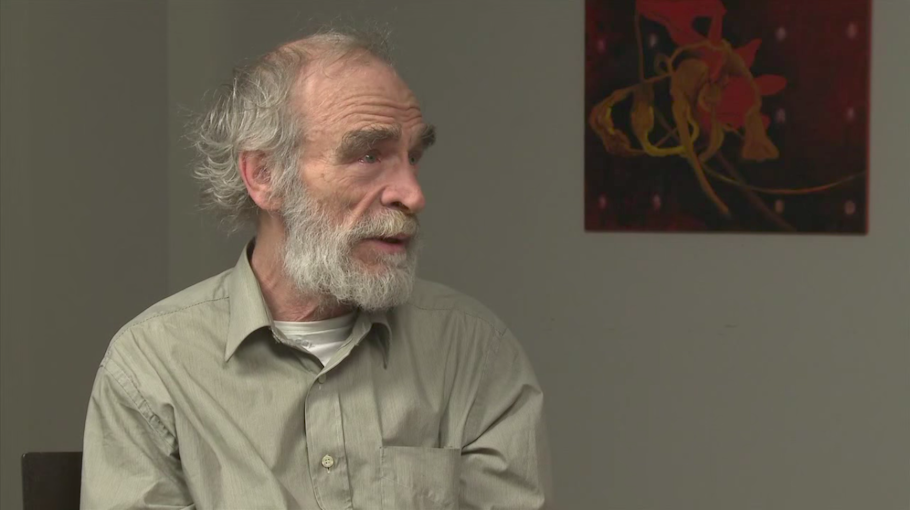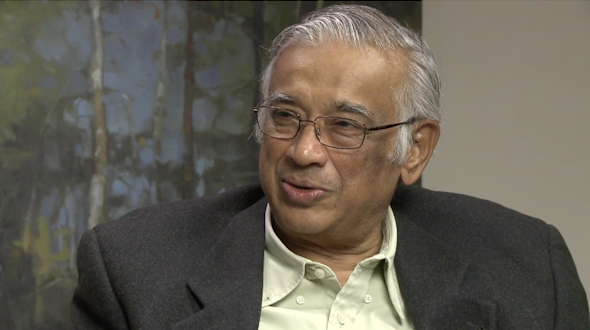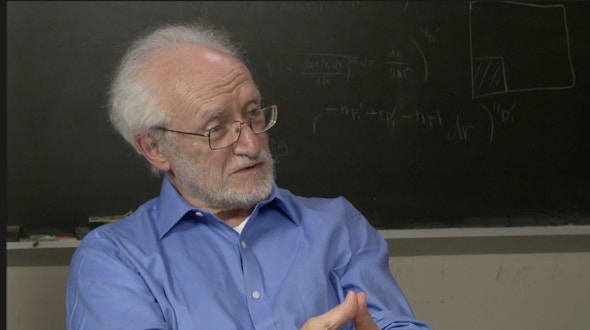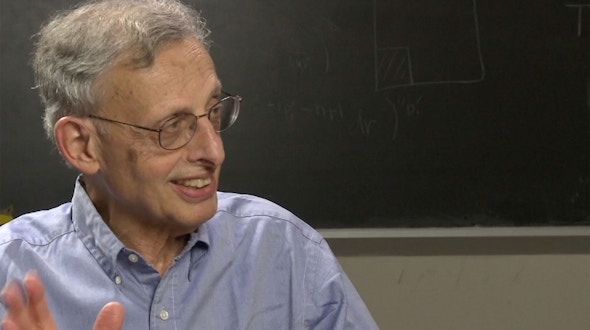Mikhail Gromov
- Highlights (2:23)
- Walking a Tightrope (2:26)
- Ergosystems How the Brain Makes Mathematics (4:10)
- Getting Interested in Mathematics (5:05)
- V.A. Rokhlin (3:57)
- Other People in Moscow at the Time (2:00)
- Early Papers, Eliashberg's H - Principle (3:50)
- Gelfand (1:46)
- Working His Way Out of the USSR (3:27)
- The Line in Mathematics Between Being Able to do Anything and Doing Nothing (6:51)
- Coming to the U.S. (5:09)
- A Good Definition Embodies a Great Idea (5:59)
- Quantitative Topology (1:36)
- Colleagues at Stony Brook (2:18)
- Rienmannian Geometry on Manifolds with Singularities (6:27)
- The Elusive Theorem on Actions of Hyperbolic Groups (2:51)
- Proofs of Bárány's Theorem on Heavily Covered Points (2:54)
- Bridging Different Fields (2:36)
- Symplectic Geometry (4:28)
- Ways of Looking (4:11)
- Geometrization in Topology (3:22)
- Carnot-Carathéodory Spaces (5:59)
- Favorite Unsolved Conjectures (5:11)
- Problems in Artificial Intelligence (5:45)
- Feyman's Observation About Mathematicians (1:38)
- Being Responsible (5:46)
- Friendship with Misha Brin (3:01)
- Process of Understanding and Writing Books (7:13)
- Goal-Free Learning (18:22)
- Mistakes in Diagnosis and Mistakes in Judgement (16:30)
- The Beautiful Elsewhere (7:15)
- Individuality in the USSR (4:25)
- Individuality Terror and Control (6:20)
- Literature (7:53)
- Painting (1:05)
- Two Papers Experiment (1:11)
- Being Young Behaving Young (4:31)
- Energy (2:33)
- Orangutans, Topologists and Evolution (7:22)
- Connecting Mathematics to Biology (5:56)
- Open Problems in Groups of Polynomial Growth (5:42)
After courting Misha Gromov for 18 months, there I finally stood on a perfect Paris day at the Odéon metro station in the heart of the Left Bank, wondering whether the man might not, in the end, stand me up.
Gromov splits his time between France’s Institut des Hautes Études Scientifiques and New York University’s Courant Institute of Mathematical Sciences. This makes him a difficult mathematician to catch in person. And as his fellow mathematicians would attest, he’s not so easy to catch intellectually, either.
I spotted him amid the busy streetscape, like a rare bird. Then again, Gromov looks more the part of a birder, his white baseball cap angled upward atop Darwinian hairiness, his shirt tightly tucked. We made our way to a café and ordered Perrier, whereupon things got philosophical, fast.
“What is mathematics? The question is absurd,” he said.
In the tradition of Parisian “cafés philosophiques,” conversations such as ours have been known to roam from Santa Claus to truth and beauty to sex and death and probably taxes, too. I wanted to talk to Gromov about his notion of “a bug on a leaf” and what he calls the “ergologic” of how the brain does math. These are the sorts of things he thinks a lot about, at least lately.
In 2009 he won the Abel Prize, the so-called Nobel of mathematics, “for his revolutionary contributions to geometry.” And Gromov himself is bit of a revolutionary: unconventional, unorthodox, nonconformist, wild.
After receiving the Abel Prize, he was asked to write a brief autobiographical essay for publication in a book featuring recent prize winners. John Milnor’s essay begins, “I grew up in Maplewood, New Jersey … ” And John Tate began with: “What follows is a sketch of some incidents in my education and early career … ” Gromov opened with an existential crisis: “After a few frustratingly unsuccessful attempts to write my biography, I have arrived at the inevitable conclusion that this is a logically impossible task. Mind you, there are many counterexamples to this ‘non-existence conjecture’ … ”
To wit, from Wikipedia: “Mikhail Leonidovich Gromov (also spelled Mikhael Gromov or Michael Gromov … ), is a French-Russian mathematician known for important contributions in many different areas of mathematics.” And according to the MacTutor History of Mathematics, Gromov attended Leningrad University, graduating with a master’s degree (the equivalent of a doctorate) in 1965. In 1970, he was invited to the International Congress of Mathematicians in Nice, France, but authorities in the USSR prevented him from attending. Nonetheless, his proposed lecture, “A Topological Technique for the Construction of Solutions of Differential Equations and Inequalities,” was published in the proceedings, thus marking his debut on the mathematical world stage.
Gromov’s early work, including his thesis, extended ideas advanced by John Nash, now at Princeton University, Stephen Smale of the University of California, Berkeley, and Anthony Phillips of Stony Brook University. “After his thesis generalized my thesis beyond recognition,” recalled Phillips, “he went on to revolutionize geometry. He invented very general constructions that gave new insights and new results. It was new stuff, new math.”
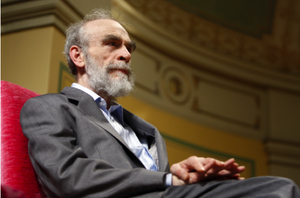
Gromov’s first bombshell was the homotopy principle, or “h-principle,” a general way of solving partial differential equations. “The geometric intuition behind the h-principle is something like this,” explained Larry Guth of the Massachusetts Institute of Technology. “If you had a sweater and you wanted to put it into a box, then because the sweater is soft, it is easy to put it into the box, and there are lots of ways to do it. But if you had to write a list of totally precise instructions about exactly how to put the sweater into the box, it would actually be hard and kind of complicated.” In mathematics, the question was whether some high-dimensional object could be embedded into a given space. “And the only way to deal with high-dimensional objects, at least traditionally,” said Guth, “was to write down equations that say precisely where everything goes, and it’s hard to do that. Like the situation with the sweater, the only way that we could describe how to put the sweater into the box was to write a completely precise list of instructions about exactly how to do it, and it makes it look as if it is complicated. But Gromov found a good way of capturing the idea that the sweater is very soft, hence you can do almost anything and it will fit into the box.”
Fittingly enough, Gromov’s approach is often called “soft” geometry, as opposed to the more coarse or hard variety (required when dealing with less squeezable objects such as a metal rod or even a piece of paper). But Gromov himself is anything but soft. He’s wiry and muscular, a tightrope walker in his youth. He’s incredibly energetic and extremely fast. He thinks fast, and he talks fast. “He cannot slow down,” said Phillips, who likens a conversation with Gromov to standing in front of a fire hydrant cranked open at full force. “It just keeps coming.”
•••
When Gromov began thinking about leaving the USSR, Phillips played a role in facilitating his emigration to the United States. “When I heard he was thinking of emigrating, I thought, ‘Well, why doesn’t he come to Stony Brook?’ I got in touch with Jim Simons [then chairman of the math department], and he was very enthusiastic. He said, ‘When he comes, we’ll have a position for him.’ I sent him a coded letter, saying that if he could get out of the Soviet Union, he could come to Stony Brook, he’d have a job here.”
“Everybody was in shock at how amazing this guy was,” recalled Jeff Cheeger, now at the Courant Institute. “After talking with Misha for a few weeks, I said to [the mathematician] Dennis Sullivan, ‘I have the impression that half of what is known in Riemannian geometry is known only to Gromov.” Which is to say, Cheeger was impressed, but even so, some months later, he was surprised by the awestruck response of another colleague, Detlef Gromoll. “He said, ‘Misha is one of the great minds of the century. He understands everything in the simplest possible way. I don’t know how he does it.’ Initially my reaction was, ‘Well, let’s not get carried away here.’ But after thinking about it for a while, I decided, ‘Wow, he may have a point.’ And by now, by common consensus, Gromov would indeed be considered one of the greatest mathematicians of the past century.”
Dusa McDuff of Barnard College was similarly impressed when she got to know Gromov at Stony Brook. “Gromov has a reputation as being very wild, having very wild ideas. He builds these amazing, powerful arguments out of almost nothing.”
Once, when explaining the idea behind an intricate proof, Gromov drew a squiggle on a piece of paper that resembled the profile of a skyscraper. Said McDuff: “This was the main idea of the proof: The squiggle represented a very sharp and controlled deformation that allows one to prove the existence of certain symplectic structures that nobody except him would ever have imagined.”
Another of Gromov’s revolutionary contributions, achieved at Stony Brook, involved what he called the “symplectic circus act,” passing a big ball through a small hole (with a family of motions preserving the symplectic structure). The crucial question was: Could this feat be done or not? As Blaine Lawson of Stony Brook recalls, “Gromov said the answer to this question was the key to symplectic geometry. And he finally figured it out some seven years later. And that paper spawned a field” — a field that has since attracted many of the brightest young geometers and topologists, a field spanning geometry and topology, now called symplectic topology. Historically, noted Lawson, symplectic geometry had been around for a very long time. “But people thought about the subject from the point of view of classical mechanics, dating back to the nineteenth century. The main change in the field came with Gromov, when he came up with his amazing theorems. He started a revolution.”
Gromov also revolutionized a certain type of group theory, the area of hyperbolic groups, importing analysis and differential geometry, and developing (albeit to a “superficial” extent, according to Gromov) William Thurston’s “fantastic” topological vision of geometric group theory. “The way I see the picture,” said Gromov, “is that … we took two different, but sometimes overlapping, routes: Thurston concentrated on the most beautiful and difficult aspects of the field (hyperbolic 3-manifolds) and myself on the most general ones (hyperbolic groups).”
And in the separate but related field of curved surfaces, he created tools now known as the Gromov-Hausdorff convergence and Gromov-Hausdorff distance that turned out to have multivarious applications. The Russian mathematician Grigori Perelman cut his teeth in this area and made use of these tools in his proof of the Poincaré conjecture.
Apart from its revolutionary caliber, Gromov’s work is also regarded as possessing a certain impenetrability (though this view is held with fondness, since the consensus has always been that Gromov’s work is correct and insightful). His first book, “Partial Differential Relations,” published in 1986, was hugely influential but at the same time pretty incomprehensible — it kept many mathematicians busy, working to understand it and translate it for the masses.
Guth read Gromov’s paper “Filling Riemannian Manifolds” many, many times, and wrote a translation (for fellow mathematicians) as well as two overview expository essays. “When I was studying Misha’s work, I thought I had a good idea about how he thought about things and his contributions,” said Guth. “And then later, whenever I talked with him, I was always completely surprised and kind of shocked by whatever he would say. It turned out I had no understanding about what he thought about things.”
“Misha has a very loose and free-ranging imagination,” said Lawson. “He loves to play with things and see what’s going on, and when he does finally get to the real point of things he just runs away with it. It’s a real spirit of originality. And he’s very much like that in person. As an individual he’s full of ideas that just flow and flow and flow.”
•••
Indeed, sitting next to Gromov in the Parisian cafe was like facing an intellectual tsunami rolling in from the Seine. I’d perused his recent “Math Currents in the Brain,” the essay version of a lecture he delivered at “Simplicity,” a conference exploring “Ideals of Practice in Mathematics and the Arts.” He began with an epigram courtesy of Descartes, “cogito ERGO sum” — “I think, therefore I am” (Gromov emphasizes the word “ergo” because the process, the “therefore” linking thinking and existence, is all-important).
From there he continued with a list of questions: “What is mathematics and how has it originated? Where does the stream of mathematical ideas flow from? What is the ultimate source of mathematics in the brain? These are reminiscent of the ancient question ‘What does the Earth rest on?’ with our instincts pushing us toward ‘On a Giant Turtle’ answers.”
The train of our conversation teetered like turtles stacked upon turtles — as that little old lady commented (as legend has it) during a Bertrand Russell lecture about the recursive conundrum of the universe: “It’s turtles all the way down!” Gromov rebuffed as absurd his own question about what mathematics is. But, he continued, “you can say, ‘How is it being created, how is it being studied, how is it being learned?’”
“The way I think of mathematics,” he said, “is as a physical and psychological process, not some abstraction.” And herein arises his notion of a “bug on a leaf,” which gives a nice sampling of his inquisitive excursions away from research mathematics proper and into biology, evolution, the structure of the brain, and the question of how scientific ideas evolve.
“A bug on a leaf displays two simple phenomena,” he said. “It always does the same thing, one leg, another leg, one leg, another leg. Just movement. Many, many things are done this way, including Euclidean geometry. That’s one point. The other point is information theoretic. And that is that the bug spends more time on the edge of the leaf compared to the interior, and more time on the tip of a leaf compared to the interior. And your eye does the same thing when looking at an image, your eye will spend more time around the image.”
Both of these processes, with the bug and the eye, in Gromov’s opinion, are run by universal mechanisms. “The logic of the world forces the way we think,” he said. “This is what I have been thinking about for the last 10 years: the basic principle underlying thinking, and specifically underlying thinking about mathematics. It’s very different from logic, it’s not logic.” He calls it “ergologic” — a reconsideration of traditional logic, encompassing the “ergo system” and the “ergo brain” and “ergo thinking.”
“Life is similar to how mathematics is organized in our brain. If you don’t accept it, life is impossible,” he said. And then one final Gromovian snippet I managed to catch was this: “If it is impossible, you try to do it anyway.”
After an hour trying to parse these nuances, my time was up. Gromov didn’t linger over au revoirs. We stood up to leave, I double-checked the tip, and as fast as that he was gone, off to run an errand with his wife.
